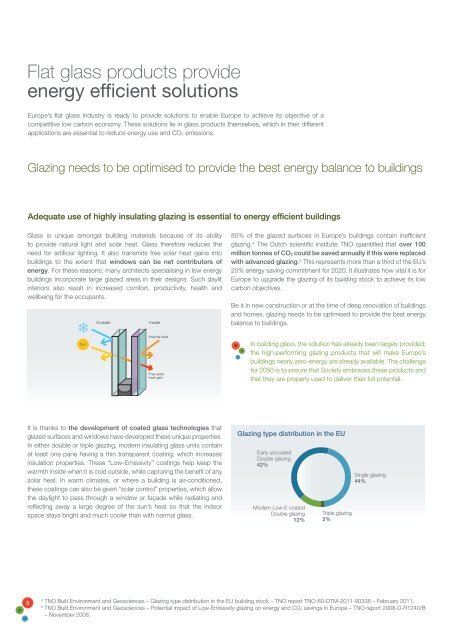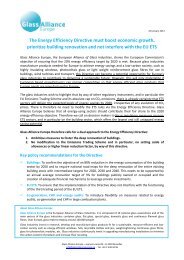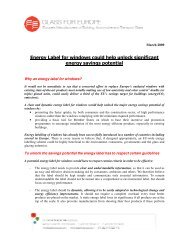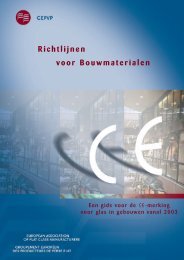Europe's flat glass industry in a competitive low ... - Glass for Europe
Europe's flat glass industry in a competitive low ... - Glass for Europe
Europe's flat glass industry in a competitive low ... - Glass for Europe
Create successful ePaper yourself
Turn your PDF publications into a flip-book with our unique Google optimized e-Paper software.
Flat <strong>glass</strong> products provide<br />
energy efficient solutions<br />
<strong>Europe</strong>’s <strong>flat</strong> <strong>glass</strong> <strong><strong>in</strong>dustry</strong> is ready to provide solutions to enable <strong>Europe</strong> to achieve its objective of a<br />
<strong>competitive</strong> <strong>low</strong> carbon economy. These solutions lie <strong>in</strong> <strong>glass</strong> products themselves, which <strong>in</strong> their different<br />
applications are essential to reduce energy use and CO2 emissions.<br />
Glaz<strong>in</strong>g needs to be optimised to provide the best energy balance to build<strong>in</strong>gs<br />
Adequate use of highly <strong>in</strong>sulat<strong>in</strong>g glaz<strong>in</strong>g is essential to energy efficient build<strong>in</strong>gs<br />
<strong>Glass</strong> is unique amongst build<strong>in</strong>g materials because of its ability<br />
to provide natural light and solar heat. <strong>Glass</strong> there<strong>for</strong>e reduces the<br />
need <strong>for</strong> artificial light<strong>in</strong>g. It also transmits free solar heat ga<strong>in</strong>s <strong>in</strong>to<br />
build<strong>in</strong>gs to the extent that w<strong>in</strong>dows can be net contributors of<br />
energy. For these reasons, many architects specialis<strong>in</strong>g <strong>in</strong> <strong>low</strong> energy<br />
build<strong>in</strong>gs <strong>in</strong>corporate large glazed areas <strong>in</strong> their designs. Such daylit<br />
<strong>in</strong>teriors also result <strong>in</strong> <strong>in</strong>creased com<strong>for</strong>t, productivity, health and<br />
wellbe<strong>in</strong>g <strong>for</strong> the occupants.<br />
Outside<br />
Inside<br />
85% of the glazed surfaces <strong>in</strong> <strong>Europe</strong>’s build<strong>in</strong>gs conta<strong>in</strong> <strong>in</strong>efficient<br />
glaz<strong>in</strong>g. 4 The Dutch scientific <strong>in</strong>stitute TNO quantified that over 100<br />
million tonnes of CO2 could be saved annually if this were replaced<br />
with advanced glaz<strong>in</strong>g. 5 This represents more than a third of the EU’s<br />
20% energy sav<strong>in</strong>g commitment <strong>for</strong> 2020. It illustrates how vital it is <strong>for</strong><br />
<strong>Europe</strong> to upgrade the glaz<strong>in</strong>g of its build<strong>in</strong>g stock to achieve its <strong>low</strong><br />
carbon objectives.<br />
Be it <strong>in</strong> new construction or at the time of deep renovation of build<strong>in</strong>gs<br />
and homes, glaz<strong>in</strong>g needs to be optimised to provide the best energy<br />
balance to build<strong>in</strong>gs.<br />
Sun<br />
Internal heat<br />
Free solar<br />
heat ga<strong>in</strong><br />
In build<strong>in</strong>g <strong>glass</strong>, the solution has already been largely provided:<br />
the high-per<strong>for</strong>m<strong>in</strong>g glaz<strong>in</strong>g products that will make <strong>Europe</strong>’s<br />
build<strong>in</strong>gs nearly zero-energy are already available. The challenge<br />
<strong>for</strong> 2050 is to ensure that Society embraces these products and<br />
that they are properly used to deliver their full potential.<br />
It is thanks to the development of coated <strong>glass</strong> technologies that<br />
glazed surfaces and w<strong>in</strong>dows have developed these unique properties.<br />
In either double or triple glaz<strong>in</strong>g, modern <strong>in</strong>sulat<strong>in</strong>g <strong>glass</strong> units conta<strong>in</strong><br />
at least one pane hav<strong>in</strong>g a th<strong>in</strong> transparent coat<strong>in</strong>g, which <strong>in</strong>creases<br />
<strong>in</strong>sulation properties. These “Low-Emissivity” coat<strong>in</strong>gs help keep the<br />
warmth <strong>in</strong>side when it is cold outside, while captur<strong>in</strong>g the benefit of any<br />
solar heat. In warm climates, or where a build<strong>in</strong>g is air-conditioned,<br />
these coat<strong>in</strong>gs can also be given “solar control” properties, which al<strong>low</strong><br />
the daylight to pass through a w<strong>in</strong>dow or façade while radiat<strong>in</strong>g and<br />
reflect<strong>in</strong>g away a large degree of the sun’s heat so that the <strong>in</strong>door<br />
space stays bright and much cooler than with normal <strong>glass</strong>.<br />
Glaz<strong>in</strong>g type distribution <strong>in</strong> the EU<br />
Early uncoated<br />
Double glaz<strong>in</strong>g<br />
42%<br />
Modern Low-E coated<br />
Double glaz<strong>in</strong>g<br />
12%<br />
Triple glaz<strong>in</strong>g<br />
2%<br />
S<strong>in</strong>gle glaz<strong>in</strong>g<br />
44%<br />
8<br />
4<br />
TNO Built Environment and Geosciences – Glaz<strong>in</strong>g type distribution <strong>in</strong> the EU build<strong>in</strong>g stock – TNO report TNO-60-DTM-2011-00338 – February 2011.<br />
5<br />
TNO Built Environment and Geosciences – Potential impact of Low-Emissivity glaz<strong>in</strong>g on energy and CO2 sav<strong>in</strong>gs <strong>in</strong> <strong>Europe</strong> – TNO report 2008-D-R1240/B<br />
– November 2008.

















